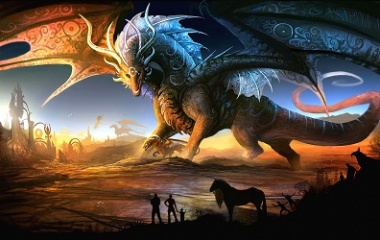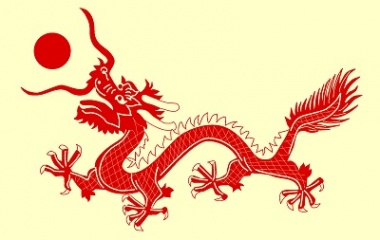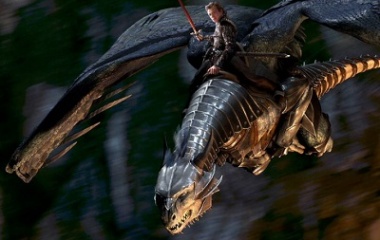What is a Dragon?
It depends on who you ask! These world-famous creatures come in all different shapes, sizes, and dispositions. From small symbols of luck to giant, fire-breathing foes, Dragons are full of surprises.
Characteristics
Physical Description
If Dragons existed, they would probably be a genus rather than a species. Several, distinct types of Dragon are scattered across the globe.
Chinese Dragons (also popular in Japan and Korea), have long, snake-like bodies and four short legs. Their long necks support large, doggish heads with fluttering manes, whiskers that look like dangerous whips, and sometimes antlers! Their backs are covered in scales, and their bellies are plated in hard armor. A ridge of spikes runs down their spine. Their bodies are usually bright red or green, but their faces are an eruption of many vibrant colors.
European Dragons (also called wyrms) are reptilian, like their Chinese cousins, but instead of resembling snakes with oversized heads, they resemble lizards, with compact bodies, powerful legs, long tails, long necks, and small, horned heads. Their colors are somber, usually dark shades of red, blue, or green. The crowning-glory of the European Dragon is its wings, which can stretch out to great widths and cast a terrifying shadow when it is soaring above.
Finally, sea serpents can be classified as a type of Dragon. These watery creatures are like a cross between their Chinese and European cousins, having long, wingless bodies with somber colors, and small heads. Since they live in the water, they don’t have legs, and they may or may not have flippers. Sea serpents are the largest of all the Dragons. Some of them are so enormous that it is impossible to see from their head to their tail!
Personality
The Latin root of the word Dragon is drak, which means “watch closely” or “see clearly.” The tag holds true. Whatever else Dragons might be, they are always alert and on the lookout.
Chinese Dragons are symbols of luck and majesty. They watch over the worthy people of Earth, helping emperors protect their thrones and scaring demons away from villages. Although they are powerful—and they certainly enjoy basking in praise—they are rarely aggressive towards humans.
European Dragons, on the other hand, are highly aggressive and dangerous! Instead of guarding over villages, they pillage them, carry off their maidens and their treasure, and jealously protect it from any challengers. Their greed knows no boundaries, and they will defend their treasure trove to the death.
Of all the dragons, sea serpents are the least likely to seek out an encounter with humans. They lurk in the dark chasms of the ocean, and unless they are disturbed, they simply ignore human civilization. Still, a passing ship can provoke a serpent—and they are not friendly when their territory is invaded!
Special Abilities
The Dragons’ abilities are well-aligned with their personalities.
Chinese Dragons use their magical powers to shower blessings upon villages and dynasties. They are particularly associated with water, and they can be called upon to bring relief during a drought. They are often sought for their wisdom as well; those who can speak to humans deliver shrewd advice and even prophecies. At the very least, they can bring good luck to their favorite household.
The warlike European Dragon has much more ferocious talents. Their wings may look like bat wings, but they are as strong and agile as a hawk, allowing the beasts to fly for great distances, then dive towards the earth at a breakneck speed. They breathe fire; their bite is poisonous; and their blood is corrosive. Some European Dragons seem to act on sheer animal instinct, but others are cunning, and when they choose to speak to humans, they can weave hypnotic riddles.
Sea serpents, the most mysterious of Dragons, have variable talents. Some are capable of breathing fire, which makes the water around them boil, and others can whip up whirlpools or tidal waves.
Cultural Representation
History
Dragons appear in our earliest attempts at literature, including The Epic of Gilgamesh, The Iliad, Beowulf, and the Rigveda. What’s more, the archaeological record suggests that Dragon-lore is even older than written language.
It’s easy to prove that Dragons are an ancient race, but pinning down the origin of their legend is trickier. These mighty creatures pop up at the dawn of cultures all over the world. Even isolated cultures, like the Aborigine people in Australia, can lay claim to their own special breed, making it impossible for any single culture to claim that they invented the myth.
Still, some cultures have influenced the evolution of Dragons in other cultures. For example, the emergence of Christianity had a huge impact on Greco-Roman, then European, Dragons. The original Greco-Roman monsters were serpents, often without legs and with multiple heads. They were wild and powerful creatures, but they weren’t evil. Christianity turned them into the jealous, fire-breathing monsters that we think of today by associating them with Satan and Hell. Christianity also gave rise to the classic dragon-hunting hero by claiming that important saints had defeated Dragons (symbols of Satan).
Modern Appearances
Today, European Dragons continue their reign as the ultimate fairy tale villain. They have appeared in major fantasy franchises, like JRR Tolkein’s Hobbit, JK Rowling’s Harry Potter, and DB Weiss’s Game of Thrones, and they have even inspired some series all to their own, like Christopher Paolini’s Inheritance Cycle.
Video and role-playing games have capitalized on the European Dragon’s ferocious reputation by giving players a chance to face off with the legendary beasts. They appear, of course, in Dungeons and Dragons, as well as Final Fantasy, Mario, Pokemon, Zelda, and Mortal Combat.
Meanwhile, Chinese Dragons remain popular in Asian art, especially pottery and paper mache. Crowds of people don Dragon costumes and carry Dragon banners around the turn of the New Year, in order to secure good luck for the days to come.
Explanation
Despite the presence of Dragon stories all over the world, science hasn’t produced a single scrap of evidence that these massive beasts are real. Still, reality has its own monsters, and some of them may be responsible for firing up our imagination.
Dinosaurs are the closest thing the world has seen to Dragons. Indeed, some dinosaurs could rival dragons in their size and ferocity. A flying pterodactyl could probably wage a terrifying air battle with a Dragon, while a tylosaurus might have been able to bite a sea serpent in half! Of course, dinosaurs died out roughly 60 million years before humans emerged, but an ancient person who stumbled upon their bones might not know that!
Crocodiles are another prime candidate for the impetus of Dragon-lore. Various species of crocodile are scattered across the globe. In Africa and southern Europe, the fearsome Nile Crocodile can grow up to 16 feet long and weigh up to 2,400 pounds. Saltwater crocodiles, which are found in India, Indonesia, the Phillipines, and Australia, can be even larger: up to 23 feet and 2,600 pounds. They might not pillage villages or horde treasure, but these deadly predators can easily claim a human life.
Large pythons and monitor lizards also have the potential to be mistaken for Dragons.
Alternatively, some researchers have theorized that Dragons spring from human instinct itself. They might be a conglomerate of proto-human predators: large mammals with claws and teeth, snakes with scales and poison, and eagles with vast wings.
Dragon






No comments:
Post a Comment